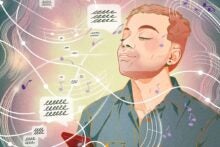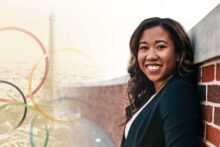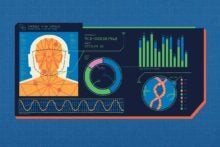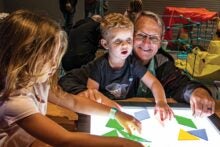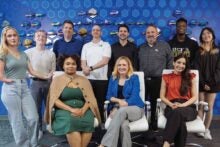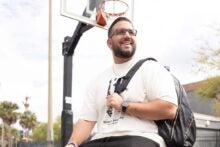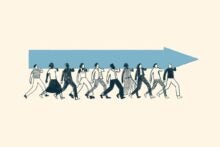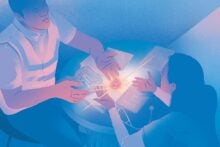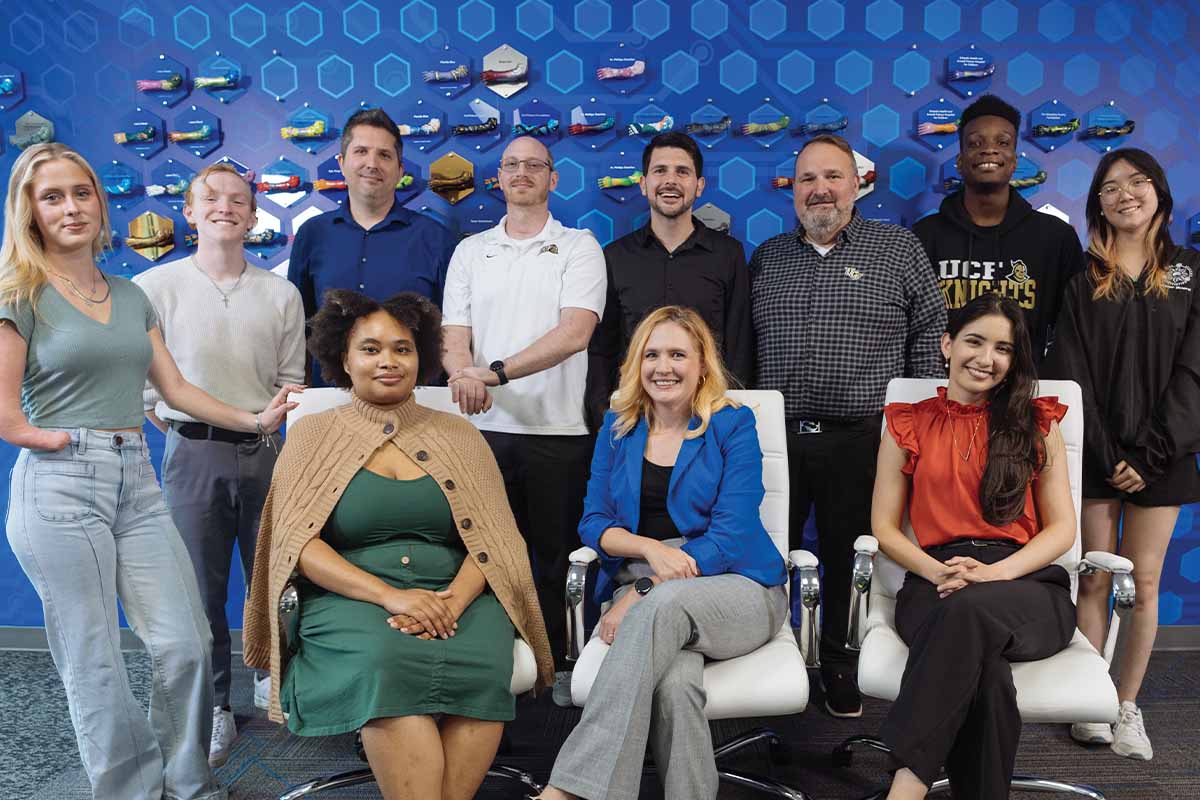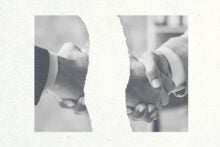
Members of the Limbitless Solutions team: (Left to right, back) Garrett Oliver, Matt Dombrowski ’05 ’08 MFA, John Sparkman ’13 ’15MS, Albert Manero ’12 ’14MS ’16PhD, Peter Smith ’05 ’12PhD, Anthony Martin and Grace Yip. (Left to right, front): Annika Emmert, Nadia Wilson, Angie Carloss ’04 ’18MPA and Viviana Rivera ’23.
Inside the Limbitless Solutions headquarters, a nervous child arrives with their excited parents. They’re greeted by a friendly team eager to present them with a package — a box that contains much more than colorful plastic and electronic components. The child has a limb difference, but due to the box’s design, they’re still able to open it themselves — finding a prosthetic arm featuring custom art. It’s a purposeful accessory that brings out their inner superhero, princess or video game character.
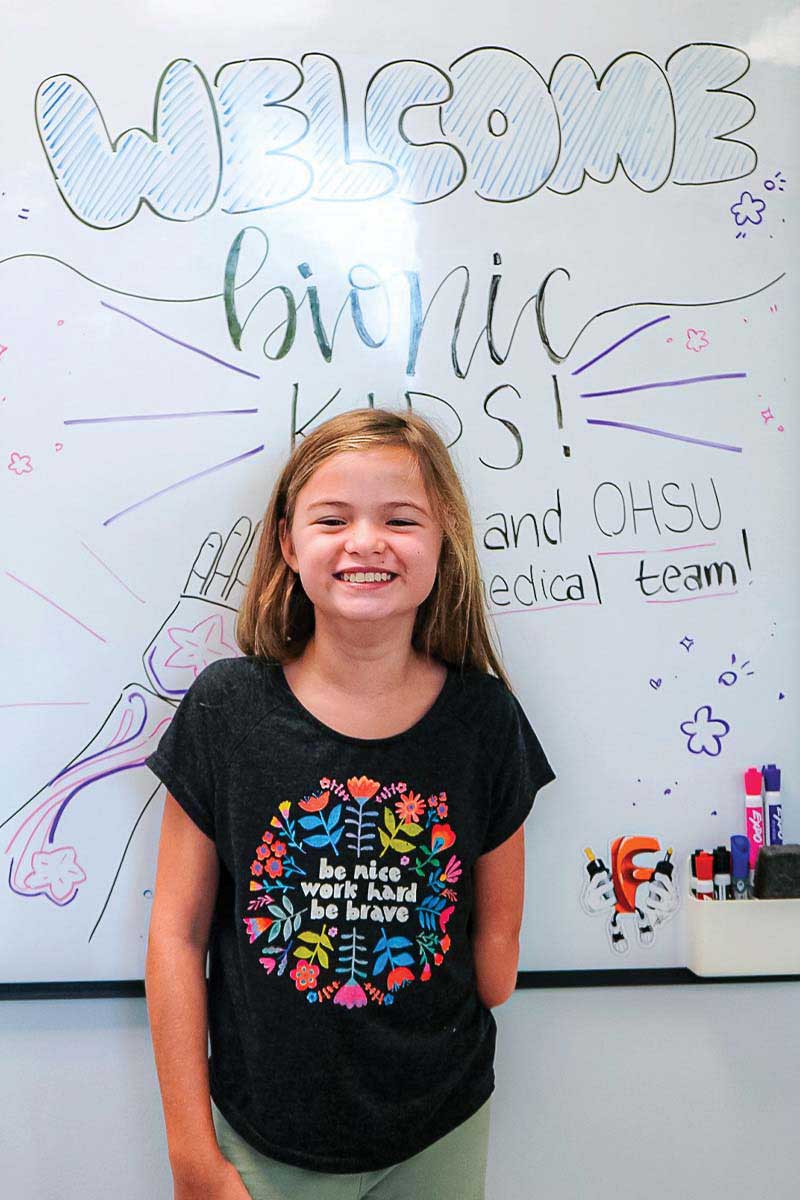
It’s a moment full of emotions — excitement, pride and relief, among many others — for everyone in the room. For the team at Limbitless, moments like these over the past decade have continued to drive the UCF-based organization to create bionic prosthetic limbs.
“We’ve seen kids get their arm on Friday and then come in on Saturday walking differently. You can literally see they’re standing up straighter and feeling more confident,” says Limbitless Solutions Director of Administration, Operations and Outreach Angie Carloss ’04 ’18MPA, an interdisciplinary studies and public administration alumna.
Functional prosthetic arms can cost $40,000 to $80,000 or more. At Limbitless, the cost of putting a child through a clinical trial with one of their custom limbs is $10,000, including travel. The kids’ families don’t cover any of this, as Limbitless’ clinical trial is funded entirely by grants, including recent ones from Walt Disney World Resort and the Pabst Steinmetz Foundation, and philanthropic gifts. Support across UCF, the Central Florida community and beyond is essential to changing the lives of Limbitless’ bionic kids and their families.
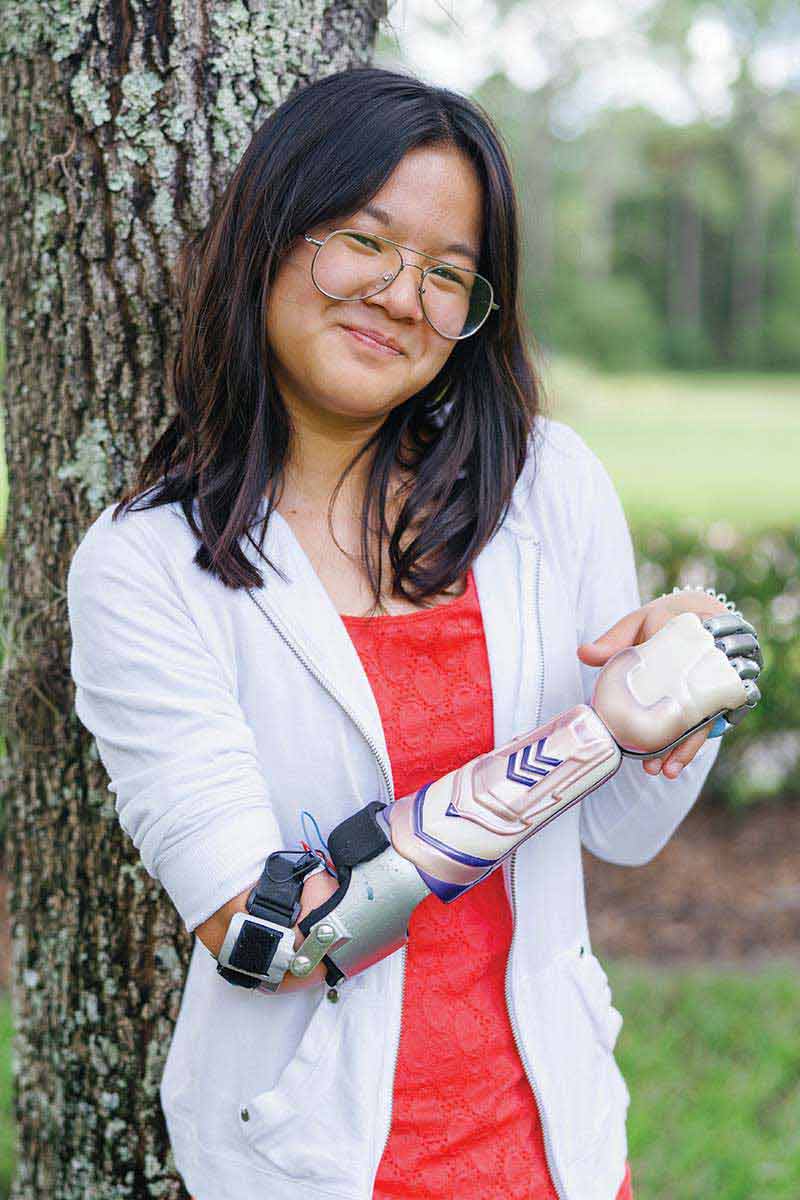
“This is one of the only areas on campus where the hardware gets up and walks out the door and into a classroom and on a playground,” says Limbitless Co-founder and Executive Director Albert Manero ’12 ’14MS ’16PhD. “This wouldn’t be possible without the support of our community who sees the value of our mission and are supporting kids in the limb difference community.”
Before it became a nonprofit, Manero’s project was inspired by a radio segment about the first 3D-printed mechanical hand in 2013. Shortly after, he gathered a team of 15 — including fellow engineers and other students from a multitude of disciplines, as well as a nurse and seamstress — to create the first 3D-printed arm for then-6-year-old Alex Pring. Manero and his team knew they had to keep going once they saw the bionic arm’s impact on Pring, who is now in high school and plays football.
“It’s been a constant pursuit of making [the arm] better,” Manero says. “We don’t sit still well.”
Part of that progression has included refining the functional design of the arms and incorporating art co-designed by the recipients. Pring received an Iron Man-inspired design and even got to meet Robert Downey Jr. one year later.
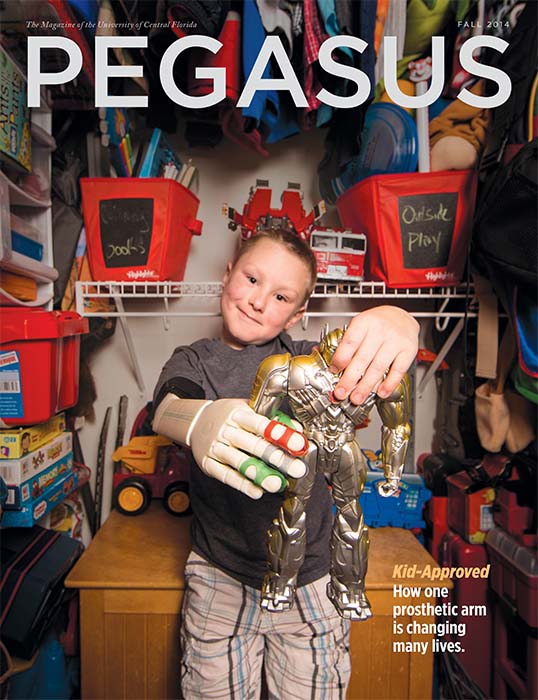
Alex Pring, featured in the Fall 2014 issue of Pegasus Magazine, with his bionic arm.
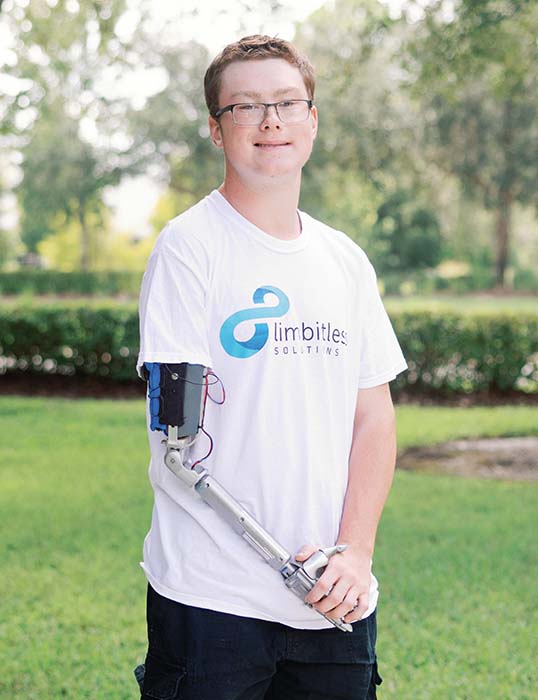
An older Alex Pring with his bionic arm.
Progress has also included adding clinical trials with national and local hospitals, which are important to understanding how to better serve children in the limb difference community.
“We’re thrilled that [Limbitless Solutions has] grown. It’s a constant pursuit of excellence,” Manero says.
The Bionic Family
That excellence is driven by Limbitless’ staff members and another “product” the organization has consciously crafted over its 10 years: a robust internship program, which recently surpassed its 500th student.
Among the 56 interns selected for the Spring 2024 program is someone with a personal connection to Limbitless: first-year health sciences major Annika Emmert, who was born without a right hand. When she was 10, she traveled from California to Orlando to pick up her bionic arm from Limbitless. The day before they were set to meet with the team, Emmert and her family visited Clearwater Marine Aquarium — home to the dolphin that inspired the movie Dolphin Tale, which she was a fan of. There she received a surprise delivery of her arm, which had a floral design nodding to her love of nature and because people often said the end of her arm looked like a flower waiting to bloom. Good Morning America was even there to capture the moment.
“My hand has finally blossomed into this beautiful flower of modern technology,” Emmert says.
When she was 12, she moved to Jacksonville, Florida, partly to be closer to Limbitless, making it easier to make adjustments to her bionic limb and advocate for those in the limb difference community. She participated in the organization’s first clinical trial, which was announced in 2018, and helped create designs for additional clinical trials.
“Limbitless has given me a new way of life that I couldn’t have even imagined.”
With Limbitless by her side, Emmert has even presented internationally on what it’s like growing up with a limb difference. She doesn’t take her responsibility as an advocate lightly since she says she knows what it feels like to think you’re the only person who has a body like yours.
“Limbitless has given me a new way of life that I couldn’t have even imagined,” Emmert says. “If you were to tell 9-year-old me that I was going to be able to live out a life where I could advocate for people all around the world with disabilities by speaking at the United Nations [six times] and the World Health Organization, I would not know what to say. But Limbitless has given me the voice to be able to speak for others when they cannot speak for themselves.”
Before receiving her bionic arm, Emmert says she was seen as an easy target on the soccer field and in games with other children. When she was “it” during tag, the activity turned into an “infection game” because her missing limb was thought to be contagious.
After she received her bionic arm, kids would surround Emmert and say how cool it was, that they saw her on TV and that now they wanted to shake her hand.
“It was never about being able to pick things up,” Emmert says. “It’s a form of self-expression, a form of power that we get from these arms because we get to design them ourselves and work with a team who cares about giving us something that relates to us, something that’s beautiful to us, something that’s functional and makes us feel powerful. We’re bionic kids.”
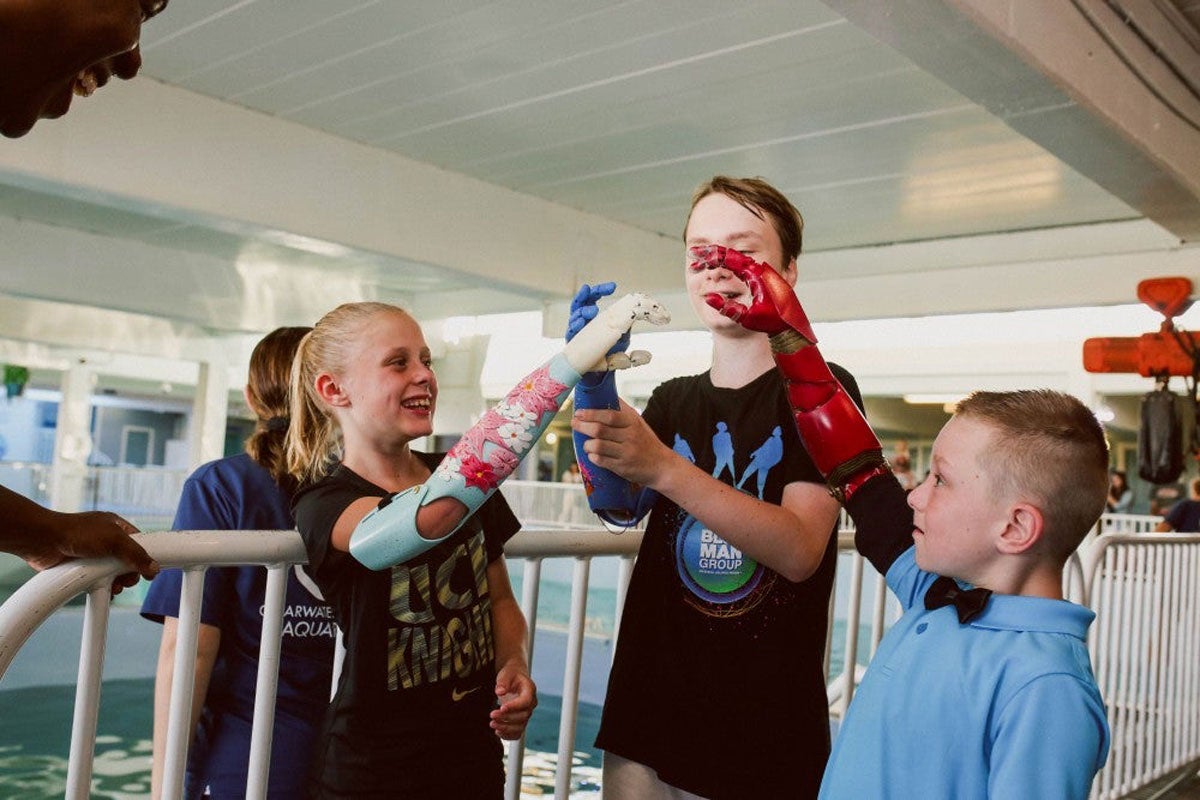
Annika Emmert as a child with other bionic kids.
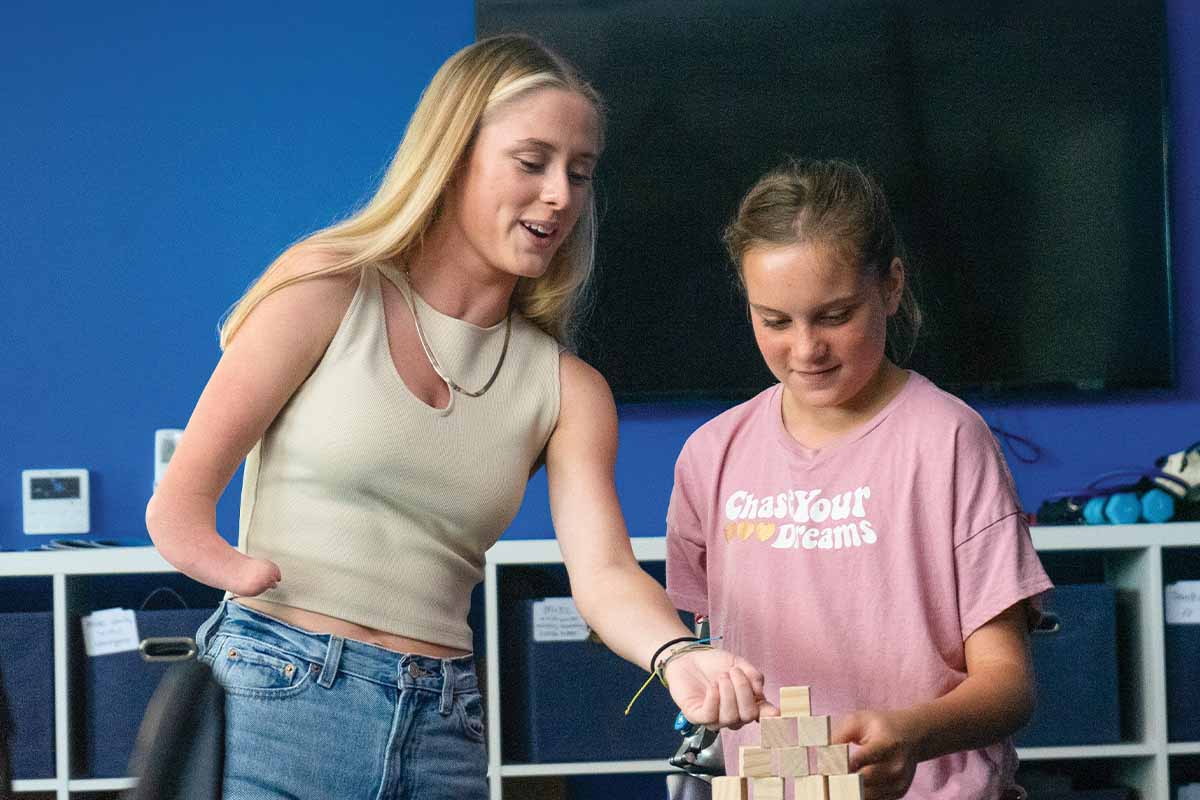
Annika Emmert helping a bionic kid as a Limbitless intern.
Empowerment is often a result not just for the bionic kids, but for every intern at Limbitless. Take biomedical sciences graduate student Viviana Rivera ’23, for instance. While she was an undergraduate student minoring in studio art, she was encouraged by a friend to apply for the team, despite her initial doubts that she’d qualify. The interdisciplinary aspects of Limbitless’ work changed her mind, with interns representing nearly every UCF college.
Taking the chance to apply rewarded her with opportunities that have enhanced her art skills, helped her grow research experience and improve her professionalism. It’s also helped squash her self-doubts around becoming a doctor. After she graduates in the fall, she plans to apply to medical school.
“Limbitless has taught me that I can deal with a lot more than I thought I could — that I can handle responsibility, I can handle a high workload and I can help other people in the process as well,” Rivera says. “And those are all very important aspects of being a doctor. I think that really helped shape my confidence during my time at UCF.”
So many other interns have used the confidence and skills they gained at Limbitless to accomplish their own life goals, including several alums working at companies like Electronic Arts, Lockheed Martin, Microsoft and Texas Instruments, three people starting medical school next year and a student pursuing a doctoral degree in robotics at Carnegie Mellon University.
Advancing the Mission Through Art
The artistic work at Limbitless is just as important as the mechanical. A major milestone was developing video games to help the bionic kids learn how to control their artificial limbs.
In 2015, School of Visual Arts and Design (SVAD) faculty member Matt Dombrowski ’05 ’08MFA met with the Limbitless team to discuss how they could expand the inclusion of art onto the arms. Near the end of the meeting, Dombrowski referred to the Nintendo Power Glove, a controller accessory made in 1989, and brought up the idea of developing a video game for the bionic kids to better adapt to their prosthetic arms. They could play the game using electrical impulses from their muscles, helping teach them to use their bionic limb.
“It was never about being able to pick things up. It’s a form of self-expression, a form of power that we get from these arms because we get to design them ourselves and work with a team who cares about giving us something that relates to us, something that’s beautiful to us, something that’s functional and makes us feel powerful.”
— Annika Emmert, health sciences student, and Limbitless Solutions intern and past recipient
Limbitless was on board. However, Dombrowski, a visual artist, wanted more expertise for the gamification and hardware development. He reached out to his research partner Peter Smith ’05 ’12PhD, a fellow faculty member with 15 years of game design experience, including developing serious games for training across education, the U.S. military and the White House.
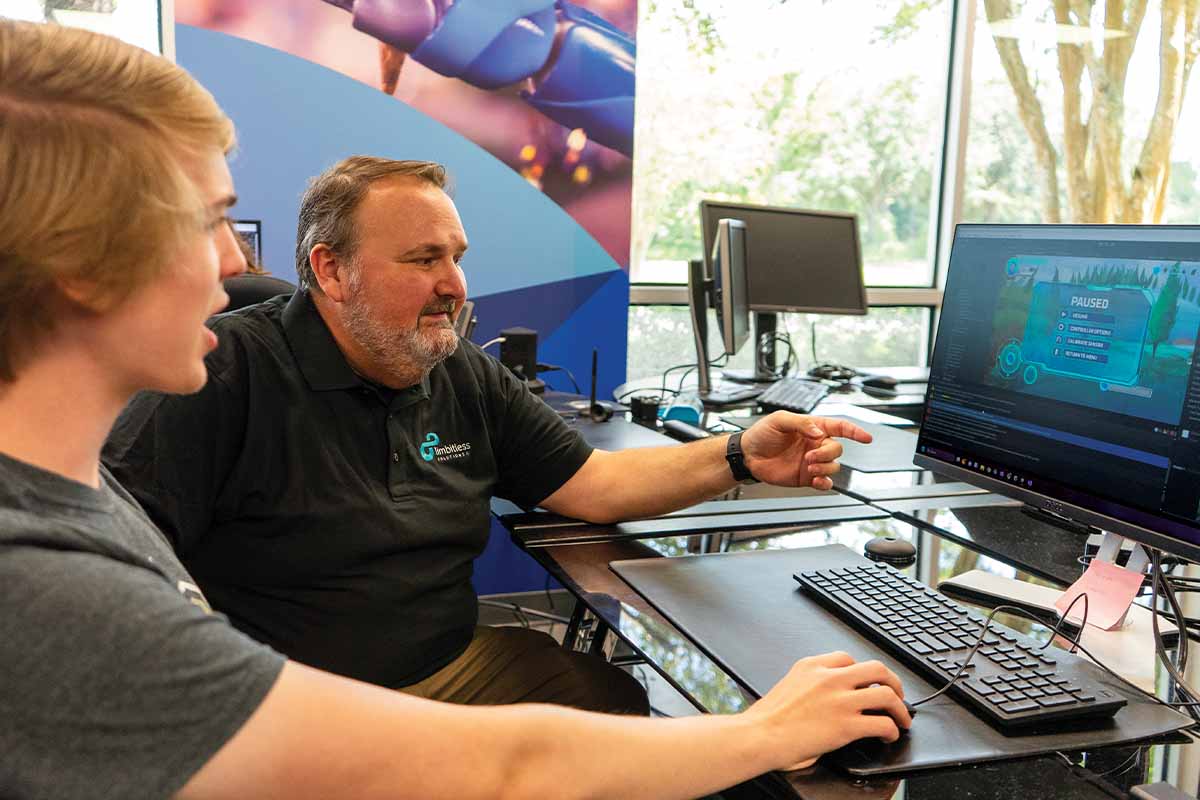
Limbitless’ Head of Game Development and Training Peter Smith ’05 ’12PhD helping a student intern.
Over the next year, Dombrowski and Smith worked with UCF Casual Game Production undergraduate students in Smith’s class to develop five prototype games. Shortly after, they attended a presentation of arms to a few bionic kids. Once they saw how excited the kids were to receive their arms and play the games, they knew they had to join forces with Limbitless and continue their commitment. Eight years later, Dombrowski serves as head of creative arts and media, and Smith is head of game development and training for the organization.
“Peter and I both came from the commercial industry before education, and we’ve never seen any of the products we’ve ever created have that impact on a human,” says Dombrowski, who was recognized by Adobe and featured on Forbes’ 2023 Creators to Watch list in conjunction with Limbitless. “And knowing that our amazing UCF undergraduate students were a part of it makes it even more special as educators.”
Since 2016, Dombrowski and Smith have worked with students and interns to continue elevating the art of Limbitless’ arms and develop two more in-depth games, including their most popular options: runner and side-scrolling-style games.
“Over the years, we have approached the lab as an opportunity for students to hone their professional skills in a safe and inspiring environment,” Dombrowski says. “Our stance is that all creatives, artists, game designers [and other contributors] — they should be compensated for their creative work to our mission. This occurs financially and through ‘compensation of the soul.’ ”
Dombrowski and Smith’s team has even developed a game to train people with limited mobility to use a second Limbitless device called Project Xavier, a patented technology that uses facial movements for hands-free wheelchair control. The device went through a clinical trial that launched in 2019 with the Mayo Clinic, with results published in the Journal of NeuroEngineering and Rehabilitation.
“At Limbitless, we want to create an enjoyable and immersive way for our bionic kids to learn how to use their accessibility technology while also gaining key insights about each of their specific needs,” says Smith, an associate professor in UCF’s Nicholson School of Communication and Media, and deputy assistant director for the games and interactive media program. “Seeing our students excel and have their hard work in the lab recognized through so many public venues, like the Game Developers Conference and the Smithsonian, is a goal of every educator.”
And Limbitless’ impact through the arts has endured. They also inspired then-9-year-old arm recipient Zachary Pamboukas and his family to create The Bionic Kid comic book series in 2016 to raise funds to help other bionic kids. The Pamboukases brought their story idea to Dombrowski and SVAD faculty member Victor Davila ’97 ’07MFA, who teamed up with SVAD students and spent the next few years creating two comics. To date, they’ve raised over $20,000, which added two children to the bionic family.
“That inspiring ‘Limbitless moment’ for Zachary paid it forward in the future,” Dombrowski says.
Spreading Awareness, Impacting Accessibility
Limbitless is also using generative artificial intelligence (AI) to help with branding and content development for social posts, spreading awareness of the organization and limb difference community. In 2023, the nonprofit presented on how it’s incorporating the technology in its work at Adobe MAX, a creativity conference produced by the software company. In previous years, Limbitless led talks on nonprofit STEAM research, and how art and technology can be used together to make a difference in the world.
With a strong belief in the good that Limbitless does and the need for accessibility inclusivity, Adobe has even provided funding for the nonprofit. Adobe also dedicated a section of last year’s MAX conference to the topic.
“There’s been a huge shift the last couple of years of organizations genuinely valuing that — putting in entire teams or departments that are solely focused on product accessibility,” says Mrudula Peddinti ’18, Limbitless’ director of branding, visual storytelling and user experience. “We have a couple of corporate partners that we’re very lucky to be able to work with, [and] a lot of these big companies have been leaning more into making sure, ‘Is our software accessible? Are we doing right in the industry? Are we supporting people enough?’ And really focusing on that.”
For Peddinti, who started as an intern with the nonprofit, accessibility is at the forefront of everything she does — spanning graphics, websites, apps, the packaging of the bionic limbs and internship training. She also designed the flow of Limbitless’ 5,000-square-foot facility with the bionic kids in mind.
Truly, the bionic kids are always in mind. And after a decade of dedication, there is still so much more awareness to spread. So many more improvements and advancements to make. And so many more children for Limbitless to serve.
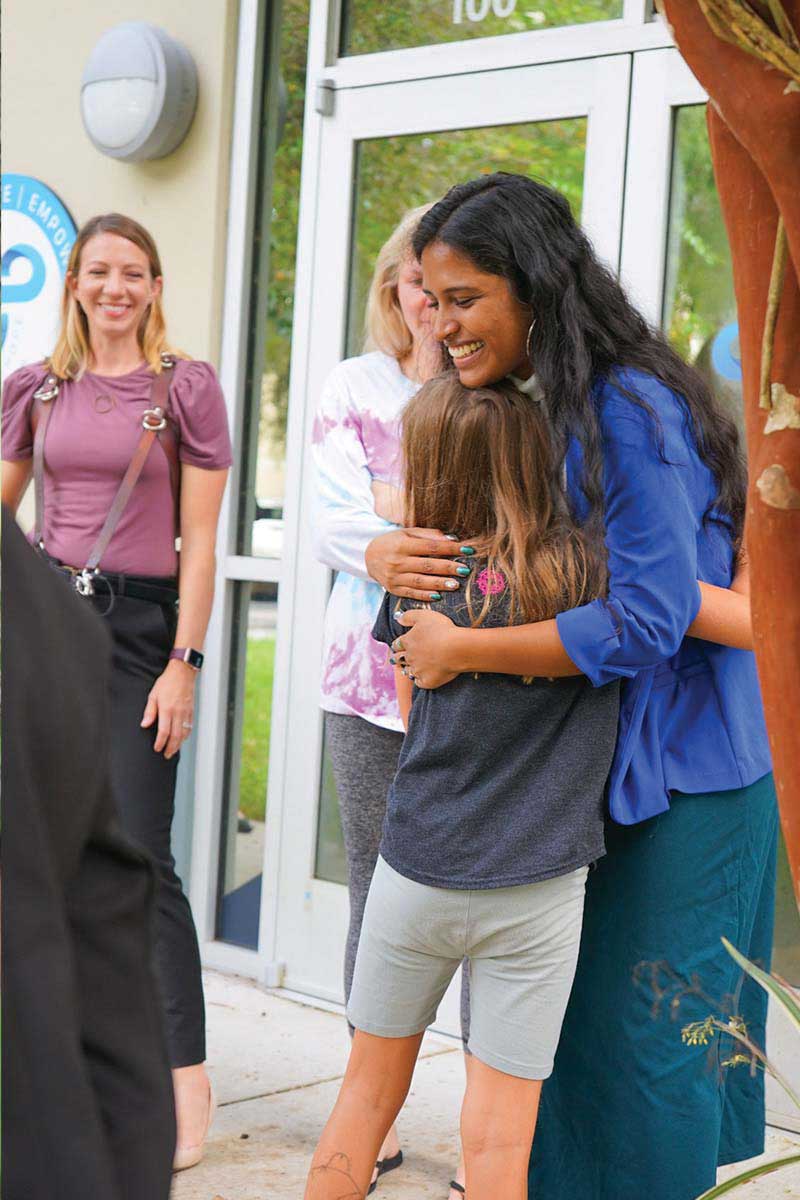
Mrudula Peddinti ’18 hugging a bionic kid.
Help support 150+ student internships each year as they help create bionic arms for kids in need.
Give Now

